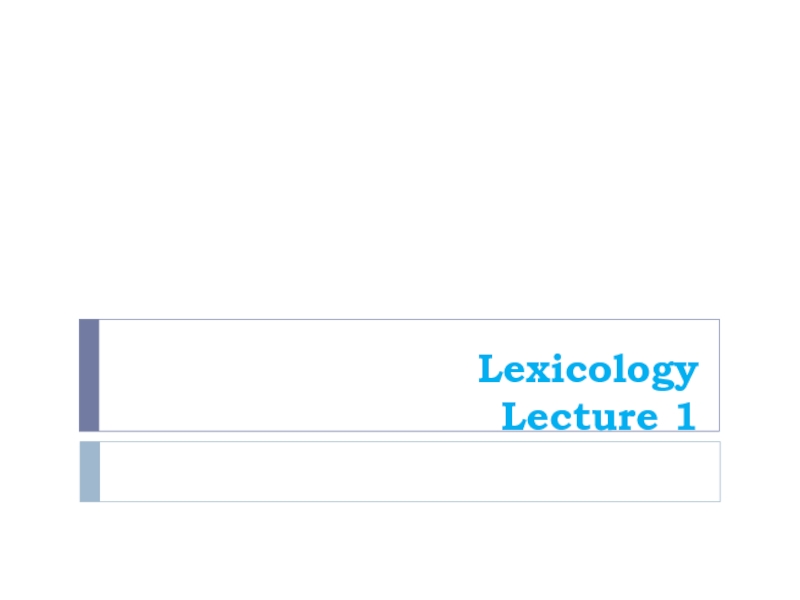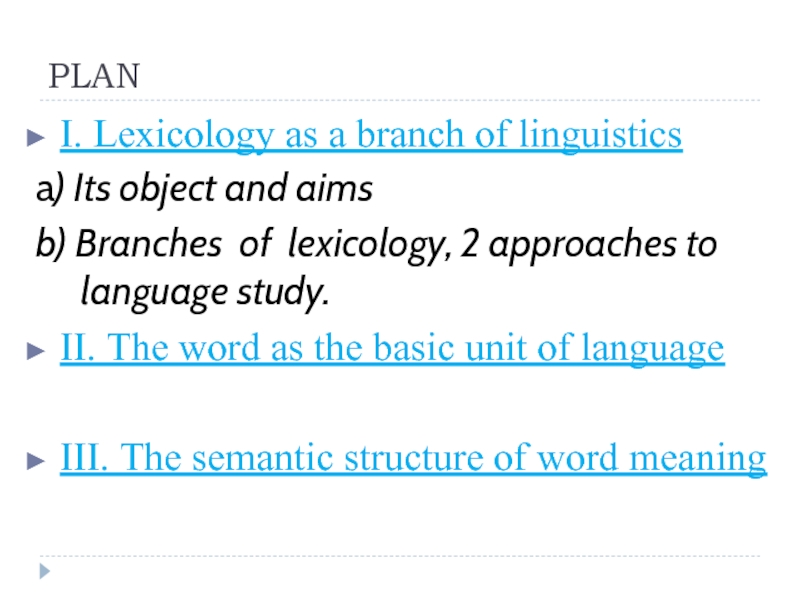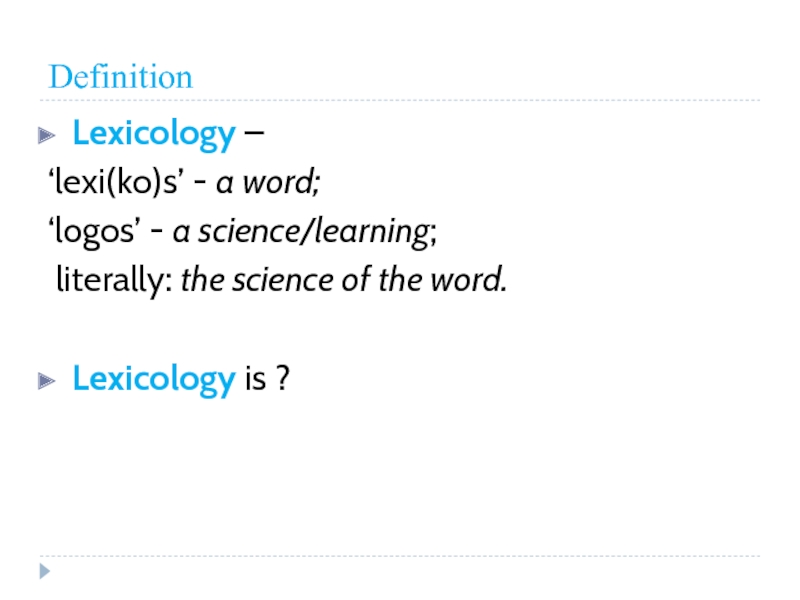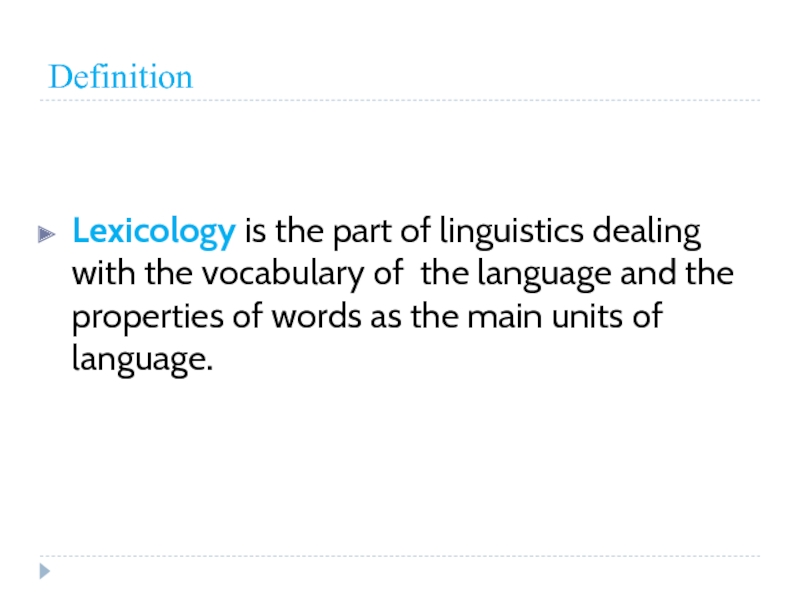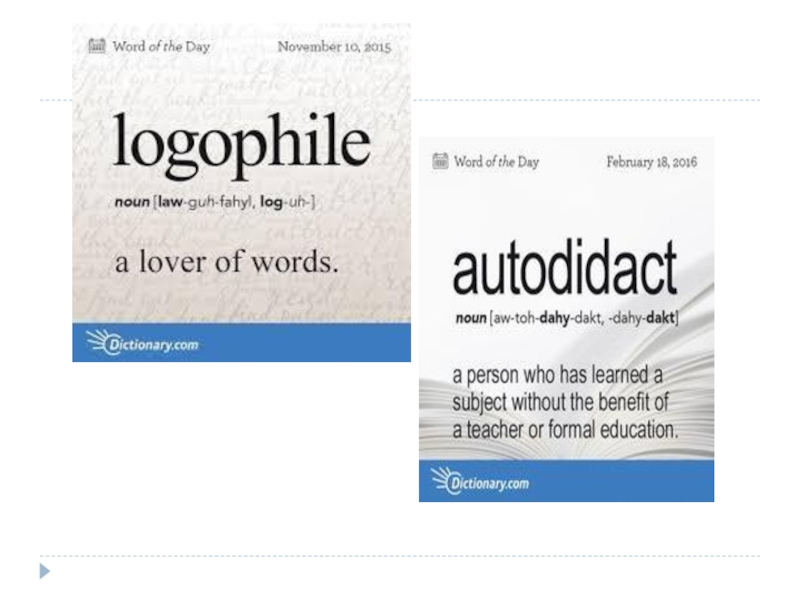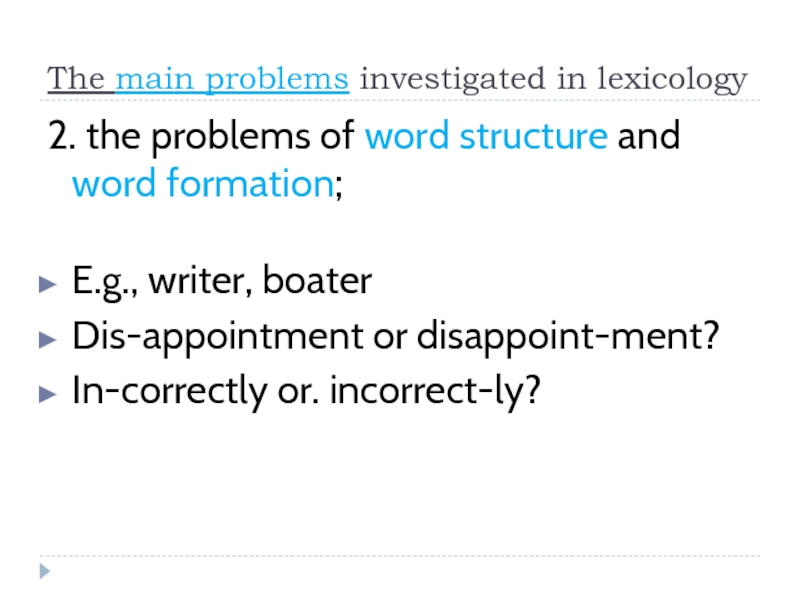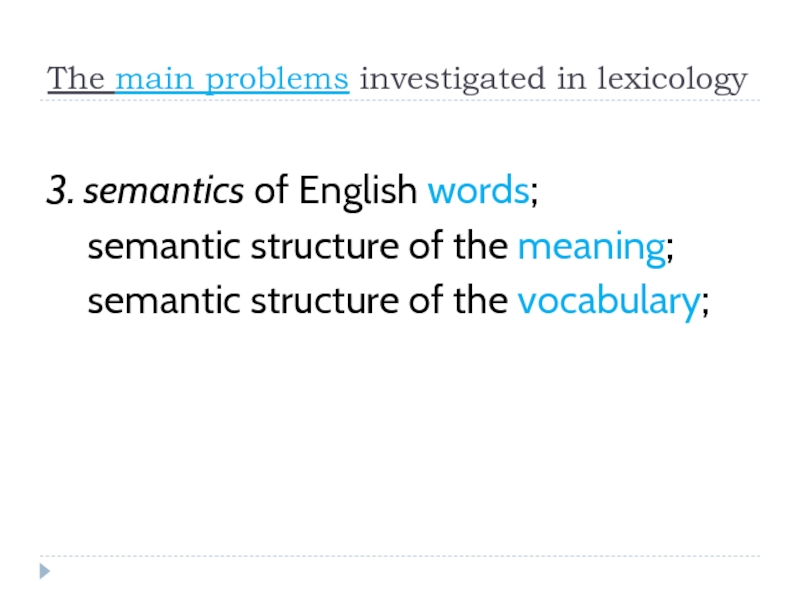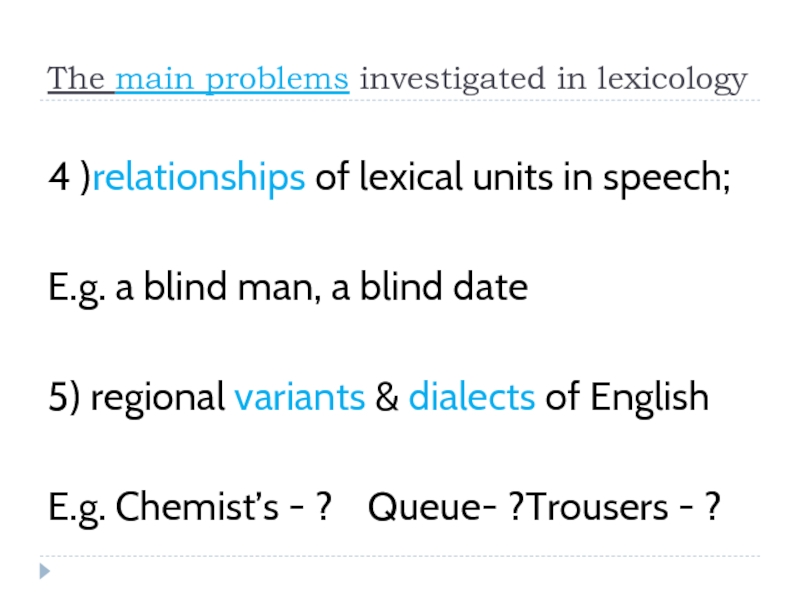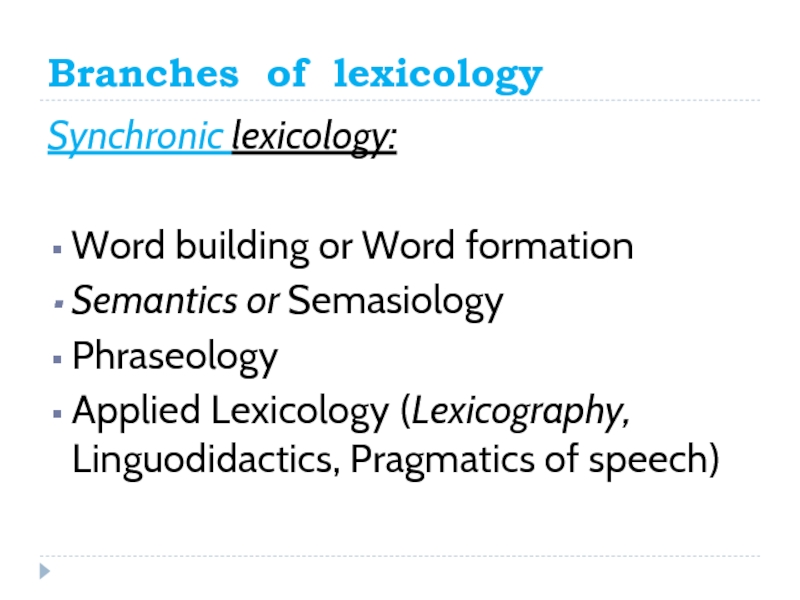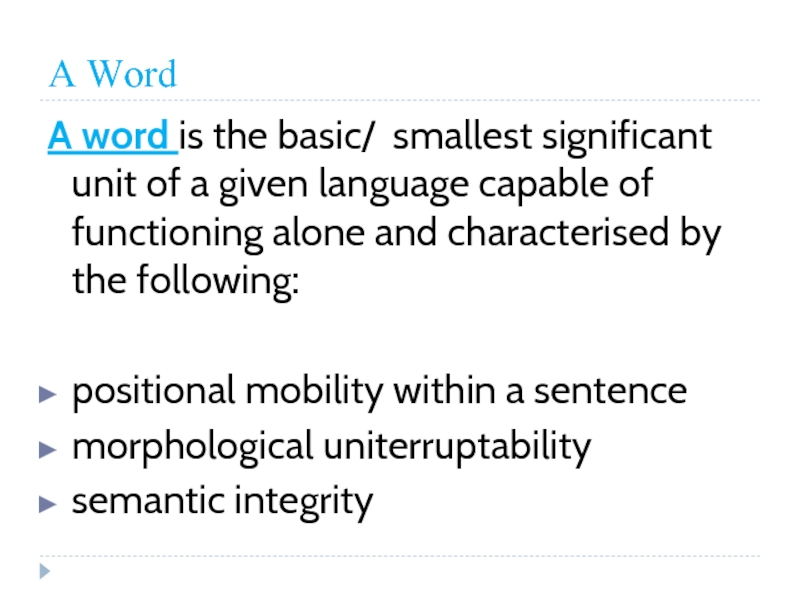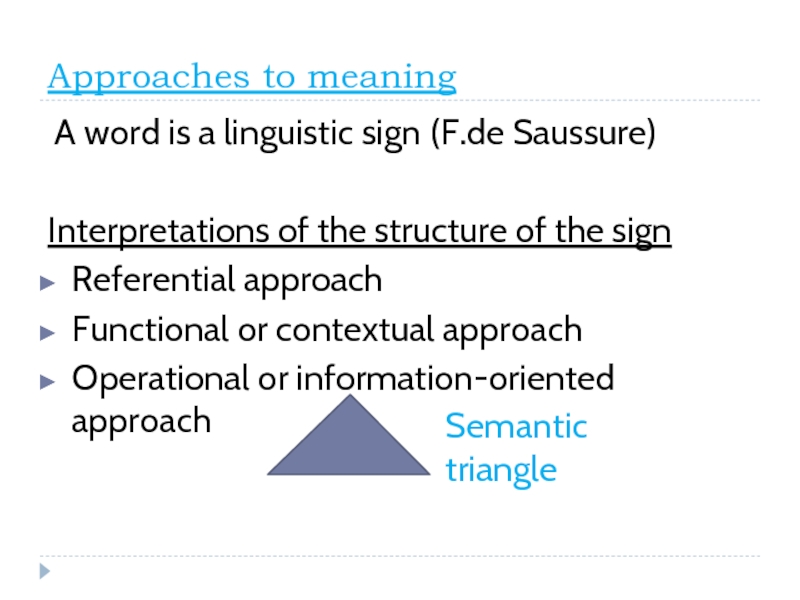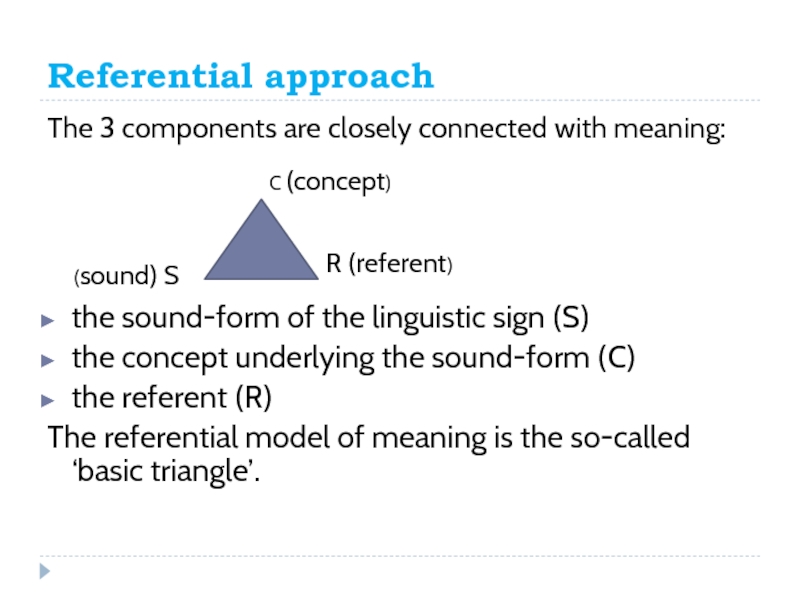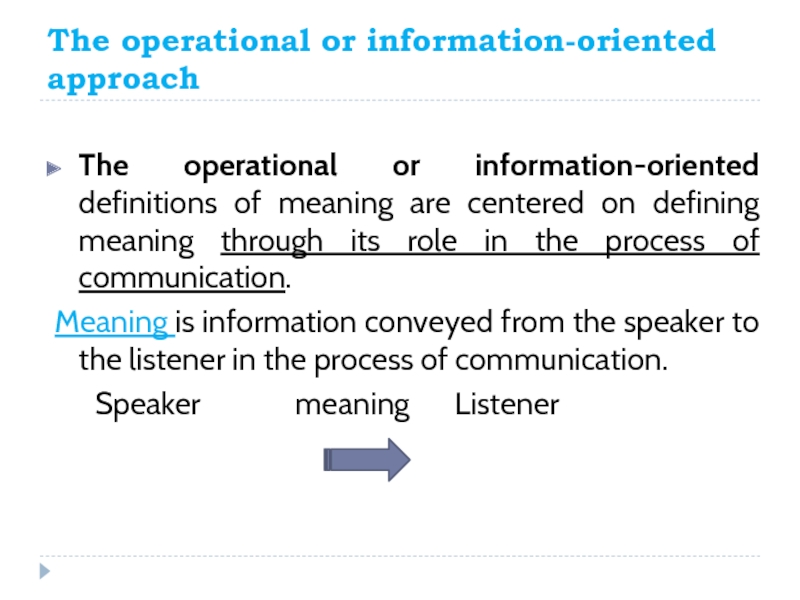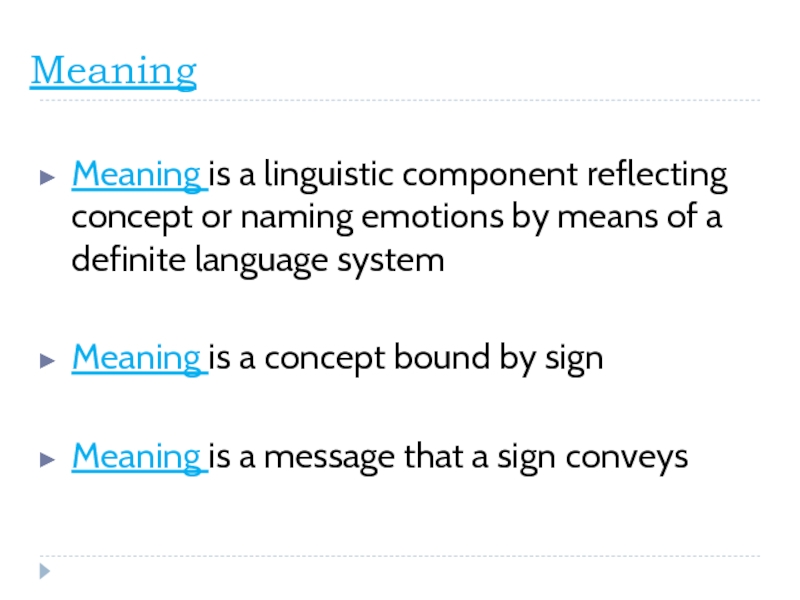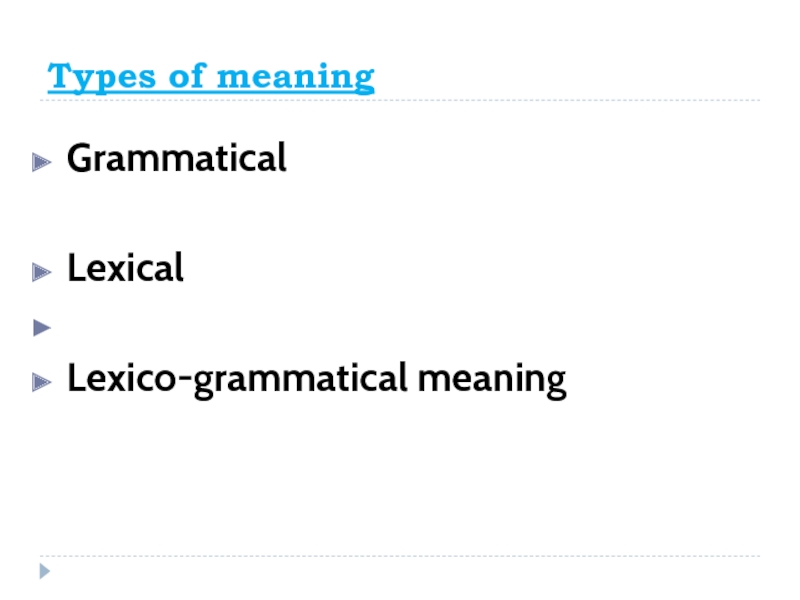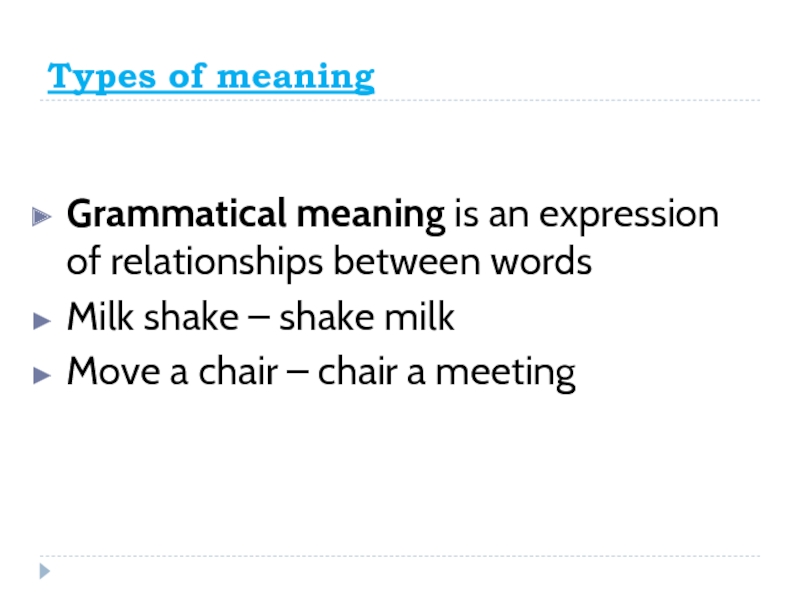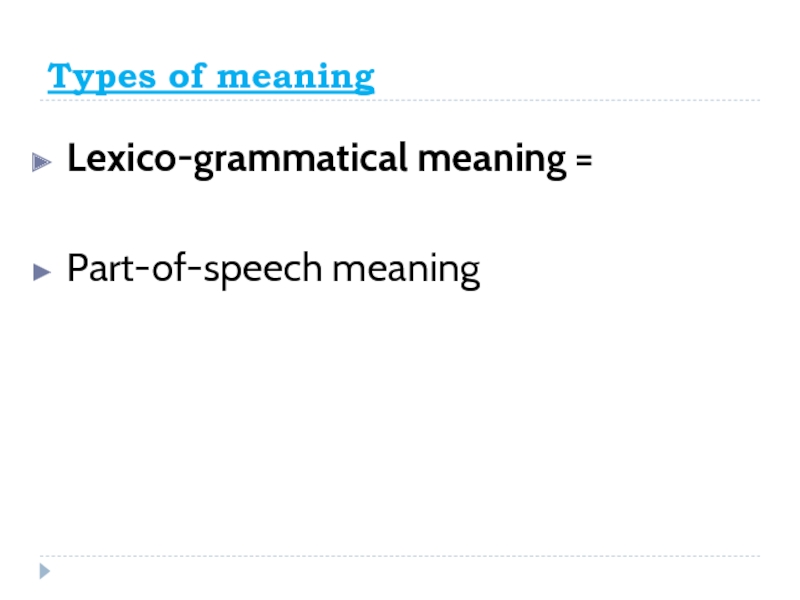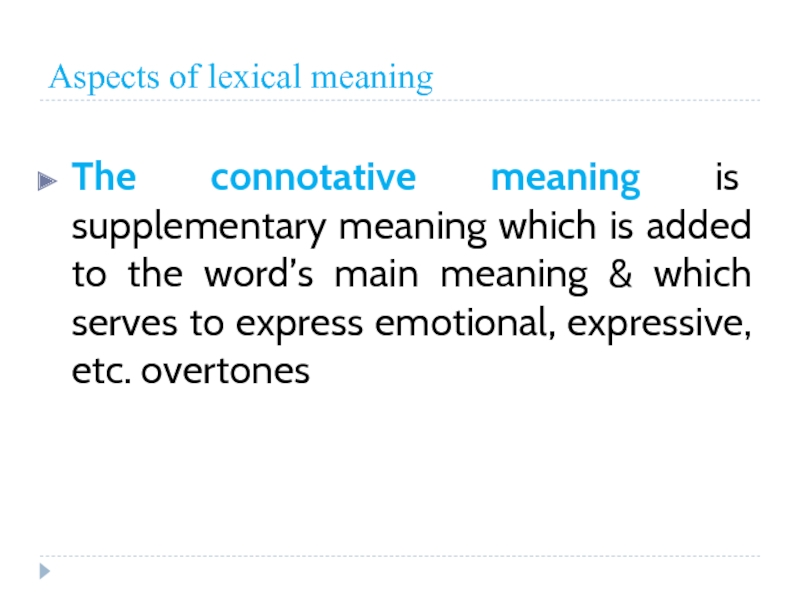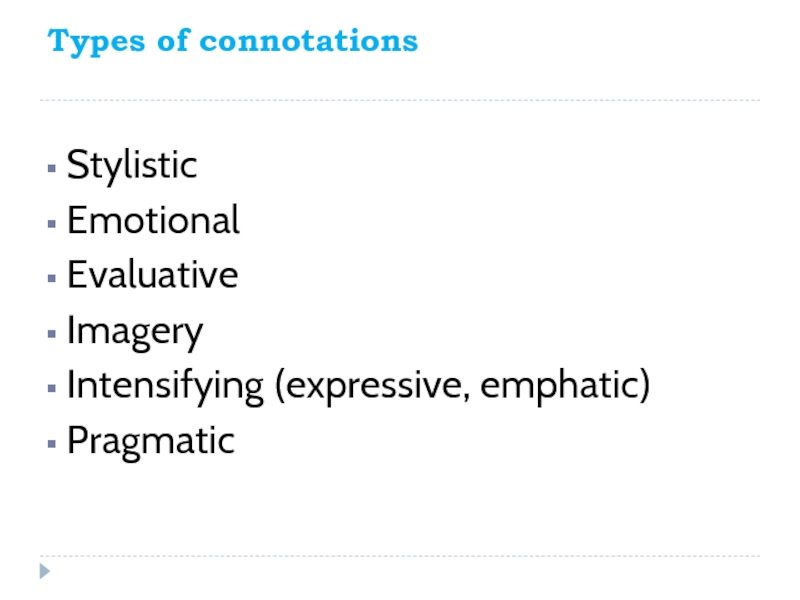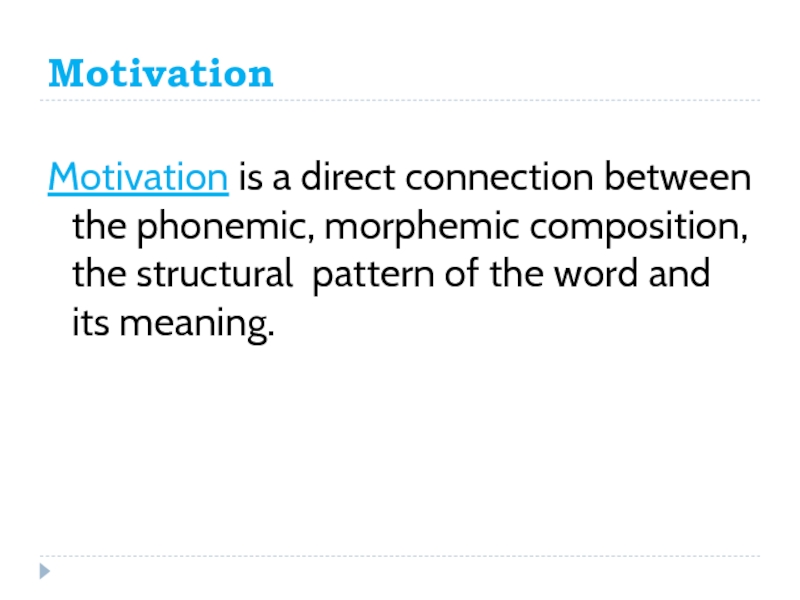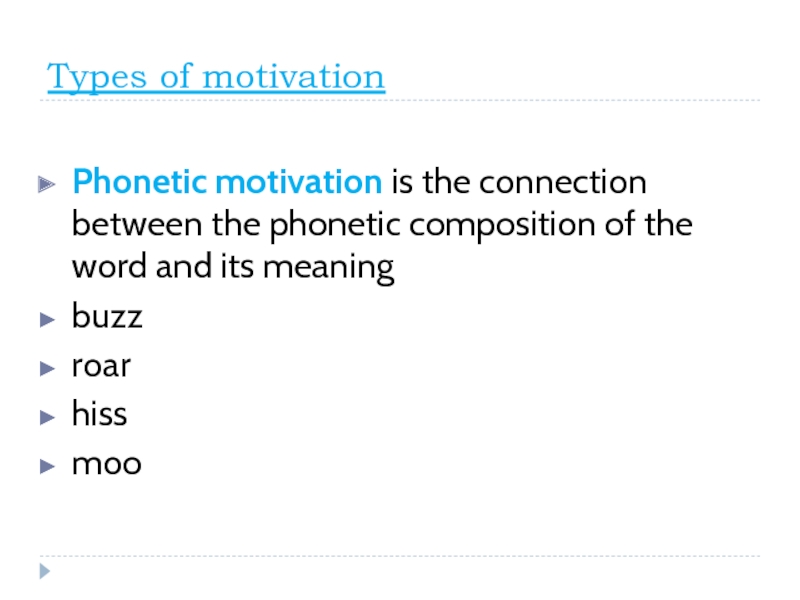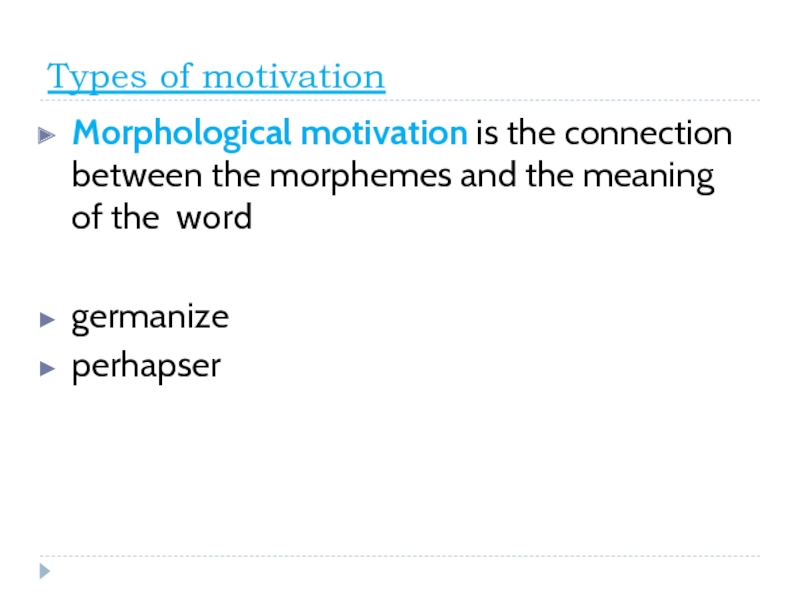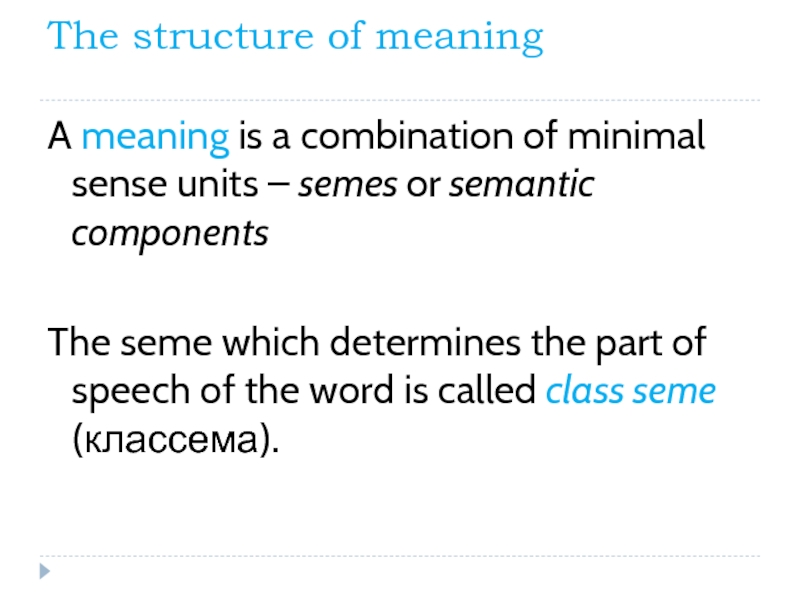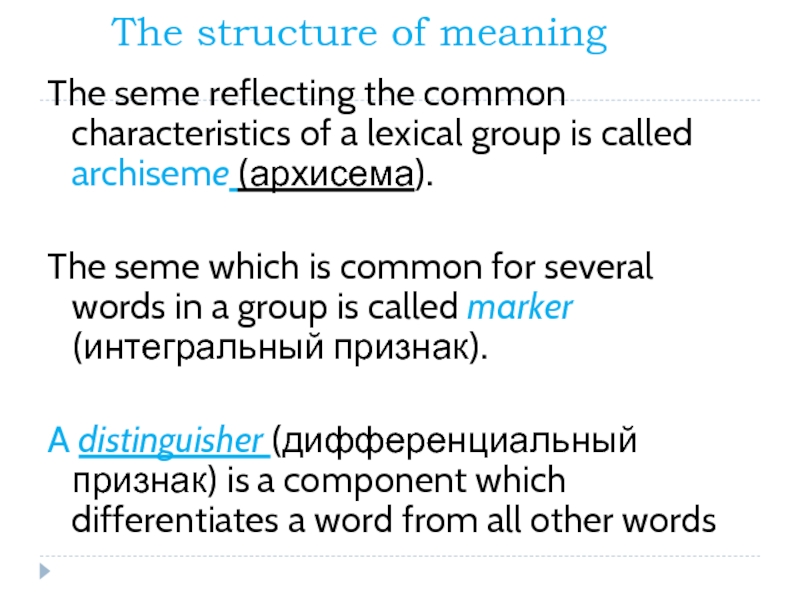- Главная
- Разное
- Дизайн
- Бизнес и предпринимательство
- Аналитика
- Образование
- Развлечения
- Красота и здоровье
- Финансы
- Государство
- Путешествия
- Спорт
- Недвижимость
- Армия
- Графика
- Культурология
- Еда и кулинария
- Лингвистика
- Английский язык
- Астрономия
- Алгебра
- Биология
- География
- Детские презентации
- Информатика
- История
- Литература
- Маркетинг
- Математика
- Медицина
- Менеджмент
- Музыка
- МХК
- Немецкий язык
- ОБЖ
- Обществознание
- Окружающий мир
- Педагогика
- Русский язык
- Технология
- Физика
- Философия
- Химия
- Шаблоны, картинки для презентаций
- Экология
- Экономика
- Юриспруденция
Lexicology презентация
Содержание
- 1. Lexicology
- 2. PLAN I. Lexicology as a branch of
- 3. III. The semantic structure of word
- 4. Definition Lexicology – ‘lexi(ko)s’ - a
- 5. Definition Lexicology is the part
- 6. What does it aim at?
- 8. The main problems investigated in lexicology
- 9. The main problems investigated in lexicology 2.
- 10. The main problems investigated in lexicology
- 11. The main problems investigated in lexicology
- 12. Branches of lexicology 1.General &
- 13. Branches of lexicology Synchronic lexicology: Word
- 14. A Word A word is the basic/
- 15. Approaches to meaning A word is
- 16. Referential approach The 3 components are closely
- 17. Functional approach The meaning of a linguistic
- 18. The operational or information-oriented approach The operational
- 19. Meaning Meaning is a linguistic component
- 20. Types of meaning Grammatical Lexical Lexico-grammatical meaning
- 21. Types of meaning Grammatical meaning is
- 22. Types of meaning Lexical meaning is
- 23. Types of meaning Lexico-grammatical meaning = Part-of-speech meaning
- 24. Aspects of lexical meaning De’notative (denotational) ‘Connotative (connotational) Pragmatic
- 25. Aspects of lexical meaning The denotative
- 26. Aspects of lexical meaning The connotative
- 27. Types of connotations Stylistic Emotional Evaluative Imagery Intensifying (expressive, emphatic) Pragmatic
- 28. Motivation Motivation is a direct connection
- 29. Types of motivation Phonetic
- 30. Types of motivation Phonetic motivation is
- 31. Types of motivation Morphological motivation is the
- 32. Types of motivation Semantic motivation is
- 33. The structure of meaning A meaning
- 34. The structure of meaning The seme
Слайд 2PLAN
I. Lexicology as a branch of linguistics
a) Its object and
aims
b) Branches of lexicology, 2 approaches to language study.
II. The word as the basic unit of language
III. The semantic structure of word meaning
b) Branches of lexicology, 2 approaches to language study.
II. The word as the basic unit of language
III. The semantic structure of word meaning
Слайд 3
III. The semantic structure of word meaning
1) Approaches to meaning
2) Types
of meaning
a) lexical and grammatical meaning
b) denotative and connotative meaning
3. Motivation (The connection between meaning and form).
4. The structure of meaning
a) lexical and grammatical meaning
b) denotative and connotative meaning
3. Motivation (The connection between meaning and form).
4. The structure of meaning
Слайд 4Definition
Lexicology –
‘lexi(ko)s’ - a word;
‘logos’ - a science/learning;
literally:
the science of the word.
Lexicology is ?
Lexicology is ?
Слайд 5Definition
Lexicology is the part of linguistics dealing with the vocabulary of
the language and the properties of words as the main units of language.
Слайд 8The main problems investigated in lexicology
systematic description of the word-stock in
respect to its origin, development and current use;
E.g., A girl, cowboy, nice
E.g., A girl, cowboy, nice
Слайд 9The main problems investigated in lexicology
2. the problems of word structure
and word formation;
E.g., writer, boater
Dis-appointment or disappoint-ment?
In-correctly or. incorrect-ly?
E.g., writer, boater
Dis-appointment or disappoint-ment?
In-correctly or. incorrect-ly?
Слайд 10The main problems investigated in lexicology
3. semantics of English words;
semantic
structure of the meaning;
semantic structure of the vocabulary;
semantic structure of the vocabulary;
Слайд 11The main problems investigated in lexicology
4 )relationships of lexical units in
speech;
E.g. a blind man, a blind date
5) regional variants & dialects of English
E.g. Chemist’s - ? Queue- ?Trousers - ?
E.g. a blind man, a blind date
5) regional variants & dialects of English
E.g. Chemist’s - ? Queue- ?Trousers - ?
Слайд 12Branches of lexicology
1.General & Special Lexicology; Contrastive Lexicology
2. Historical / diachronic/
& Synchronic lexicology
Historical lexicology:
Etymology
Historical lexicology:
Etymology
Слайд 13Branches of lexicology
Synchronic lexicology:
Word building or Word formation
Semantics or Semasiology
Phraseology
Applied Lexicology
(Lexicography, Linguodidactics, Pragmatics of speech)
Слайд 14A Word
A word is the basic/ smallest significant unit of a
given language capable of functioning alone and characterised by the following:
positional mobility within a sentence
morphological uniterruptability
semantic integrity
positional mobility within a sentence
morphological uniterruptability
semantic integrity
Слайд 15Approaches to meaning
A word is a linguistic sign (F.de Saussure)
Interpretations
of the structure of the sign
Referential approach
Functional or contextual approach
Operational or information-oriented approach
Referential approach
Functional or contextual approach
Operational or information-oriented approach
Semantic triangle
Слайд 16Referential approach
The 3 components are closely connected with meaning:
the sound-form of
the linguistic sign (S)
the concept underlying the sound-form (C)
the referent (R)
The referential model of meaning is the so-called ‘basic triangle’.
the concept underlying the sound-form (C)
the referent (R)
The referential model of meaning is the so-called ‘basic triangle’.
R (referent)
(sound) S
C (concept)
Слайд 17Functional approach
The meaning of a linguistic unit can be studied only
through its relation to other linguistic units, i.e. in a context.
---------
Context is the minimum stretch of speech necessary and sufficient to determine which of the possible meanings of a polysemantic word is used.
---------
Context is the minimum stretch of speech necessary and sufficient to determine which of the possible meanings of a polysemantic word is used.
Слайд 18The operational or information-oriented approach
The operational or information-oriented definitions of meaning
are centered on defining meaning through its role in the process of communication.
Meaning is information conveyed from the speaker to the listener in the process of communication.
Speaker meaning Listener
Meaning is information conveyed from the speaker to the listener in the process of communication.
Speaker meaning Listener
Слайд 19Meaning
Meaning is a linguistic component reflecting concept or naming emotions by
means of a definite language system
Meaning is a concept bound by sign
Meaning is a message that a sign conveys
Meaning is a concept bound by sign
Meaning is a message that a sign conveys
Слайд 21Types of meaning
Grammatical meaning is an expression of relationships between words
Milk
shake – shake milk
Move a chair – chair a meeting
Move a chair – chair a meeting
Слайд 22Types of meaning
Lexical meaning is a realisation of a concept or
emotion by means of language
Слайд 25Aspects of lexical meaning
The denotative meaning reflects the concept or the
object referred to by the word
significative
demonstrative
significative
demonstrative
Слайд 26Aspects of lexical meaning
The connotative meaning is supplementary meaning which is
added to the word’s main meaning & which serves to express emotional, expressive, etc. overtones
Слайд 27Types of connotations
Stylistic
Emotional
Evaluative
Imagery
Intensifying (expressive, emphatic)
Pragmatic
Слайд 28Motivation
Motivation is a direct connection between the phonemic, morphemic composition, the
structural pattern of the word and its meaning.
Слайд 30Types of motivation
Phonetic motivation is the connection between the phonetic composition
of the word and its meaning
buzz
roar
hiss
moo
buzz
roar
hiss
moo
Слайд 31Types of motivation
Morphological motivation is the connection between the morphemes and
the meaning of the word
germanize
perhapser
germanize
perhapser
Слайд 32Types of motivation
Semantic motivation is based on the co-existence of direct
and indirect meaning of the same word on the synchronical level
foot of the mountain
A bottleneck
foot of the mountain
A bottleneck
Слайд 33The structure of meaning
A meaning is a combination of minimal sense
units – semes or semantic components
The seme which determines the part of speech of the word is called class seme (классема).
The seme which determines the part of speech of the word is called class seme (классема).
Слайд 34The structure of meaning
The seme reflecting the common characteristics of a
lexical group is called archiseme (архисема).
The seme which is common for several words in a group is called marker (интегральный признак).
A distinguisher (дифференциальный признак) is a component which differentiates a word from all other words
The seme which is common for several words in a group is called marker (интегральный признак).
A distinguisher (дифференциальный признак) is a component which differentiates a word from all other words
